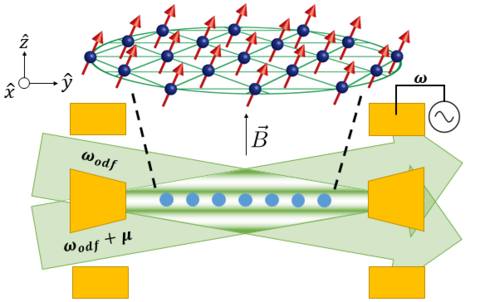Employing techniques developed for quantum information processing with trapped ions, we demonstrate a sensitive technique for measuring the amplitude of the center-of-mass motion of a two-dimensional crystal of ~100 ions stored in a Penning trap. To determine the technique's measurement imprecision, we sense motion far from the center-of-mass resonance, resolving amplitudes as small as 50 pm, 40 times smaller than the center-of-mass mode zero-point fluctuations. When performed on resonance with the center-of-mass frequency, the technique demonstrated here can enable the detection of extremely weak forces (<1 yN) and electric fields (< 1 nV/m), providing an opportunity to probe quantum sensing limits and search for physics beyond the standard model.
For more information, find the paper here: Amplitude Sensing below the Zero-Point Fluctuations with a Two-Dimensional Trapped-Ion Mechanical Oscillator. A nontechnical synopsis can be found here: Tracking a Trapped Ion Crystal.

A planar array of Beryllium ions is trapped in a Penning trap and laser cooled to temperatures below 1 mK. By sensing the spin-motion entanglement induced by a pair of optical-dipole force (odf) laser beams in the presence of a weak periodic driving force, motion below the scale of the quantum-mechanical zero-point fluctuations can be observed.

